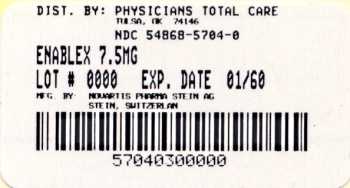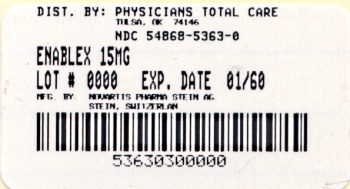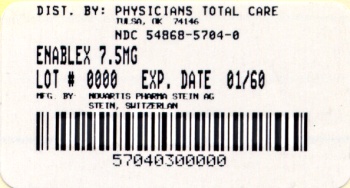Label: ENABLEX- darifenacin tablet, extended release
-
Contains inactivated NDC Code(s)
NDC Code(s): 54868-5363-0, 54868-5704-0 - Packager: Physicians Total Care, Inc.
- This is a repackaged label.
- Source NDC Code(s): 0078-0419, 0078-0420
- Category: HUMAN PRESCRIPTION DRUG LABEL
- DEA Schedule: None
- Marketing Status: New Drug Application
Drug Label Information
Updated January 1, 2010
If you are a consumer or patient please visit this version.
- Download DRUG LABEL INFO: PDF XML
- Official Label (Printer Friendly)
-
DESCRIPTION
ENABLEX® (darifenacin) is an extended-release tablet which contains 7.5 mg or 15 mg darifenacin as its hydrobromide salt. The active moiety, darifenacin, is a potent muscarinic receptor antagonist.
Chemically, darifenacin hydrobromide is (S)-2-{1-[2-(2,3-dihydrobenzofuran-5-yl)ethyl]-3-pyrrolidinyl}-2,2-diphenylacetamide hydrobromide. The empirical formula of darifenacin hydrobromide is C28H30N2O2.HBr.
The structural formula is
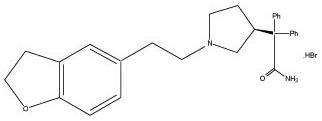
Darifenacin hydrobromide is a white to almost white, crystalline powder, with a molecular weight of 507.5.
ENABLEX is a once a day extended release tablet and contains the following inactive ingredients: dibasic calcium phosphate, hypromellose (hydroxypropyl methylcellulose), magnesium stearate, polyethylene glycol, talc, titanium dioxide. The 15-mg tablet also contains iron oxide red and iron oxide yellow.
-
CLINICAL PHARMACOLOGY
General
Darifenacin is a competitive muscarinic receptor antagonist. Muscarinic receptors play an important role in several major cholinergically mediated functions, including contractions of the urinary bladder smooth muscle and stimulation of salivary secretion.
In vitro studies using human recombinant muscarinic receptor subtypes show that darifenacin has greater affinity for the M3 receptor than for the other known muscarinic receptors (9- and 12-fold greater affinity for M3 compared to M1 and M5, respectively, and 59-fold greater affinity for M3 compared to both M2 and M4). M3 receptors are involved in contraction of human bladder and gastrointestinal smooth muscle, saliva production, and iris sphincter function. Adverse drug effects such as dry mouth, constipation and abnormal vision may be mediated through effects on M3 receptors in these organs.
Pharmacodynamics
In three cystometric studies performed in patients with involuntary detrusor contractions, increased bladder capacity was demonstrated by an increased volume threshold for unstable contractions and diminished frequency of unstable detrusor contractions after ENABLEX® (darifenacin) extended-release tablet treatment. These findings are consistent with an antimuscarinic action on the urinary bladder.
Pharmacokinetics
Absorption
After oral administration of ENABLEX to healthy volunteers, peak plasma concentrations of darifenacin are reached approximately seven hours after multiple dosing and steady-state plasma concentrations are achieved by the sixth day of dosing. The mean (SD) steady-state time course of ENABLEX 7.5 mg and 15 mg extended-release tablets is depicted in Figure 1.

Figure 1 Mean (SD) Steady-State Darifenacin Plasma Concentration-Time Profiles for ENABLEX® 7.5 mg and 15 mg in Healthy Volunteers Including Both CYP2D6 EMs and PMs*
*Includes 95 EMs and 6 PMs for 7.5 mg; 104 EMs and 10 PMs for 15 mg.
A summary of mean (standard deviation, SD) steady-state pharmacokinetic parameters of ENABLEX 7.5 mg and 15 mg extended-release tablets in extensive (EMs) and poor (PMs) metabolizers of CYP2D6 is provided in Table 1.
Table 1: Mean (SD) Steady-State Pharmacokinetic Parameters from ENABLEX® 7.5 mg and 15 mg Extended-Release Tablets Based on Pooled Data by Predicted CYP2D6 Phenotype ENABLEX® 7.5 mg
(N = 68 EM, 5 PM)ENABLEX® 15 mg
(N = 102 EM, 17 PM)AUC24
(ng.h/mL)Cmax
(ng/mL)Cavg
(ng/mL)Tmax
(h)t1/2
(h)AUC24
(ng.h/mL)Cmax
(ng/mL)Cavg
(ng/mL)Tmax
(h)t1/2
(h)EM 29.24
(15.47)2.01
(1.04)1.22
(0.64)6.49
(4.19)12.43
(5.64) a88.90
(67.87)5.76
(4.24)3.70
(2.83)7.61
(5.06)12.05
(12.37) bPM 67.56
(13.13)4.27
(0.98)2.81
(0.55)5.20
(1.79)19.95c
-157.71
(77.08)9.99
(5.09)6.58
(3.22)6.71
(3.58)7.40d
-a N=25; b N=8; c N=2; d N=1; AUC24 = Area under the plasma concentration versus time curve for 24h; Cmax = Maximum observed plasma concentration; Cavg = Average plasma concentration at steady state; Tmax = Time of occurrence of Cmax; t1/2 = Terminal elimination half-life. Regarding EM and PM, see CLINICAL PHARMACOLOGY, Pharmacokinetics, Variability in Metabolism. The mean oral bioavailability of ENABLEX in EMs at steady state is estimated to be 15% and 19% for 7.5-mg and 15-mg tablets, respectively.
Effect of Food
There is no effect of food on multiple-dose pharmacokinetics from ENABLEX extended-release tablets.
Distribution
Darifenacin is approximately 98% bound to plasma proteins (primarily to alpha-1-acid-glycoprotein). The steady-state volume of distribution (Vss) is estimated to be 163 L.
Metabolism
Darifenacin is extensively metabolized by the liver following oral dosing.
Metabolism is mediated by cytochrome P450 enzymes CYP2D6 and CYP3A4. The three main metabolic routes are as follows:
- monohydroxylation in the dihydrobenzofuran ring;
- dihydrobenzofuran ring opening;
- N-dealkylation of the pyrrolidine nitrogen.
The initial products of the hydroxylation and N-dealkylation pathways are the major circulating metabolites but they are unlikely to contribute significantly to the overall clinical effect of darifenacin.
Variability in Metabolism
A subset of individuals (approximately 7% Caucasians and 2% African Americans) are poor metabolizers (PMs) of CYP2D6 metabolized drugs. Individuals with normal CYP2D6 activity are referred to as extensive metabolizers (EMs). The metabolism of darifenacin in PMs will be principally mediated via CYP3A4. The darifenacin ratios (PM:EM) for Cmax and AUC following darifenacin 15 mg once-daily at steady state were 1.9 and 1.7, respectively.
Excretion
Following administration of an oral dose of 14C-darifenacin solution to healthy volunteers, approximately 60% of the radioactivity was recovered in the urine and 40% in the feces. Only a small percentage of the excreted dose was unchanged darifenacin (3%). Estimated darifenacin clearance is 40 L/h for EMs and 32 L/h for PMs. The elimination half-life of darifenacin following chronic dosing is approximately 13-19 hours.
Pharmacokinetics in Special Populations
Age: No dose adjustment is recommended for the elderly.
A population pharmacokinetic analysis of patient data indicated a trend for clearance of darifenacin to decrease with age (6% per decade relative to a median age of 44). Following administration of ENABLEX 15 mg once-daily, darifenacin exposure at steady state was approximately 12%-19% higher in volunteers between 45 and 65 years of age compared to younger volunteers aged 18 to 44 years (see PRECAUTIONS, Geriatric Use).
Pediatric: The pharmacokinetics of ENABLEX have not been studied in the pediatric population.
Gender: No dose adjustment is recommended based on gender. PK parameters were calculated for 22 male and 25 female healthy volunteers. Darifenacin Cmax and AUC at steady state were approximately 57%-79% and 61%-73% higher in females than in males, respectively.
Race: The effect of race on the pharmacokinetics of ENABLEX has not been characterized.
Renal Insufficiency: No dose adjustment is recommended for patients with renal impairment. A study of subjects with varying degrees of renal impairment (creatinine clearance between 10 and 136 mL/min) given ENABLEX 15 mg once daily to steady state demonstrated no clear relationship between renal function and darifenacin clearance.
Hepatic Insufficiency: The daily dose of ENABLEX should not exceed 7.5 mg once daily for patients with moderate hepatic impairment (Child Pugh B) (see PRECAUTIONS and DOSAGE AND ADMINISTRATION). No dose adjustment is recommended for patients with mild hepatic impairment (Child Pugh A).
ENABLEX pharmacokinetics were investigated in subjects with mild (Child Pugh A) or moderate (Child Pugh B) impairment of hepatic function given ENABLEX 15 mg once daily to steady state. Mild hepatic impairment had no effect on the pharmacokinetics of darifenacin. However, protein binding of darifenacin was affected by moderate hepatic impairment. After adjusting for plasma protein binding, unbound darifenacin exposure was estimated to be 4.7-fold higher in subjects with moderate hepatic impairment than subjects with normal hepatic function.
Subjects with severe hepatic impairment (Child Pugh C) have not been studied, therefore ENABLEX is not recommended for use in these patients (see PRECAUTIONS and DOSAGE AND ADMINISTRATION).
Drug-Drug Interactions
Effects of Other Drugs on Darifenacin
Darifenacin metabolism is primarily mediated by the cytochrome P450 enzymes CYP2D6 and CYP3A4. Therefore, inducers of CYP3A4 or inhibitors of either of these enzymes may alter darifenacin pharmacokinetics.
CYP2D6 Inhibitors: No dosing adjustments are recommended in the presence of CYP2D6 inhibitors. Darifenacin exposure following 30 mg once daily at steady state was 33% higher in the presence of the potent CYP2D6 inhibitor paroxetine 20 mg.
CYP3A4 Inhibitors: The daily dose of ENABLEX should not exceed 7.5 mg when coadministered with potent CYP3A4 inhibitors (e.g., ketoconazole, itraconazole, ritonavir, nelfinavir, clarithromycin and nefazodone) (see PRECAUTIONS and DOSAGE AND ADMINISTRATION). In a drug interaction study, when a 7.5 mg once-daily dose of ENABLEX was given to steady state and coadministered with the potent CYP3A4 inhibitor ketoconazole 400 mg, mean darifenacin Cmax increased to 11.2 ng/mL for EMs (n=10) and 55.4 ng/mL for one PM subject (n=1). Mean AUC increased to 143 and 939 ng.h/mL for EMs and for one PM subject, respectively. When a 15 mg daily dose of ENABLEX was given with ketoconazole, mean darifenacin Cmax increased to 67.6 ng/mL and 58.9 ng/mL for EMs (n=3) and one PM subject (n=1), respectively. Mean AUC increased to 1110 and 931 ng.h/mL for EMs and for one PM subject, respectively.
No dosing adjustments are recommended in the presence of moderate CYP3A4 inhibitors (e.g., erythromycin, fluconazole, diltiazem and verapamil). The mean Cmax and AUC of darifenacin following 30 mg once-daily dosing at steady state were 128% and 95% higher, respectively, in the presence of erythromycin. Coadministration of fluconazole and darifenacin 30 mg once daily at steady state increased darifenacin Cmax and AUC by 88% and 84%, respectively.
The mean Cmax and AUC of darifenacin following 30 mg once daily at steady state were 42% and 34% higher, respectively, in the presence of cimetidine, a mixed CYP P450 enzyme inhibitor.
Effects of Darifenacin on Other Drugs
In Vitro Studies: Based on in vitro human microsomal studies, ENABLEX is not expected to inhibit CYP1A2 or CYP2C9 at clinically relevant concentrations.
In Vivo Studies: The potential for clinical doses of ENABLEX to act as inhibitors of CYP2D6 or CYP3A4 substrates was investigated in specific drug interaction studies.
CYP2D6 Substrates: Caution should be taken when ENABLEX is used concomitantly with medications that are predominantly metabolized by CYP2D6 and which have a narrow therapeutic window, such as flecainide, thioridazine and tricyclic antidepressants (see PRECAUTIONS, Drug Interactions).
The mean Cmax and AUC of imipramine, a CYP2D6 substrate, were increased 57% and 70%, respectively, in the presence of steady-state darifenacin 30 mg once daily. This was accompanied by a 3.6-fold increase in the mean Cmax and AUC of desipramine, the active metabolite of imipramine.
CYP3A4 Substrates: Darifenacin (30 mg daily) coadministered with a single oral dose of midazolam 7.5 mg resulted in a 17% increase in midazolam exposure.
Darifenacin (10 mg t.i.d.) had no effect on the pharmacokinetics of the combination oral contraceptives containing levonorgestrel and ethinylestradiol.
Other Drugs: Darifenacin had no significant effect on prothrombin time when a single dose of warfarin 30 mg was coadministered with darifenacin (30 mg daily) at steady state. Standard therapeutic prothrombin time monitoring for warfarin should be continued.
Routine therapeutic drug monitoring for digoxin should be continued. Darifenacin (30 mg daily) coadministered with digoxin (0.25 mg) at steady state resulted in a 16% increase in digoxin exposure.
Electrophysiology
The effect of six-day treatment of 15-mg and 75-mg ENABLEX on QT/QTc interval was evaluated in a multiple-dose, double-blind, randomized, placebo- and active-controlled (moxifloxacin 400 mg) parallel-arm design study in 179 healthy adults (44% male, 56% female) aged 18 to 65. Subjects included 18% PMs and 82% EMs. The QT interval was measured over a 24-hour period both predosing and at steady state. The 75-mg ENABLEX dose was chosen because this achieves exposure similar to that observed in CYP2D6 poor metabolizers administered the highest recommended dose (15 mg) of darifenacin in the presence of a potent CYP3A4 inhibitor. At the doses studied, ENABLEX did not result in QT/QTc interval prolongation at any time during the steady state, while moxifloxacin treatment resulted in a mean increase from baseline QTcF of about 7.0 msec when compared to placebo. In this study, darifenacin 15-mg and 75-mg doses demonstrated a mean heart rate change of 3.1 and 1.3 bpm, respectively, when compared to placebo. However, in the Phase II/III clinical studies, the change in median HR following treatment with ENABLEX was no different from placebo.
- monohydroxylation in the dihydrobenzofuran ring;
-
CLINICAL STUDIES
ENABLEX® (darifenacin) extended-release tablets were evaluated for the treatment of patients with overactive bladder with symptoms of urgency, urge urinary incontinence, and increased urinary frequency in three randomized, fixed-dose, placebo-controlled, multicenter, double-blind, 12-week studies (Studies 1, 2 and 3) and one randomized, double-blind, placebo-controlled, multicenter, dose-titration study (Study 4). For study eligibility in all four studies, patients with symptoms of overactive bladder for at least six months were required to demonstrate at least eight micturitions and at least one episode of urinary urgency per day, and at least five episodes of urge urinary incontinence per week. The majority of patients were white (94%) and female (84%), with a mean age of 58 years, range 19 to 93 years. Thirty-three percent of patients were >65 years of age. These characteristics were well balanced across treatment groups. The study population was inclusive of both naïve patients who had not received prior pharmacotherapy for overactive bladder (60%) and those who had (40%).
Table 2 shows the efficacy data collected from 7- or 14-day voiding diaries in the three fixed-dose placebo-controlled studies of 1,059 patients treated with placebo, 7.5 mg or 15 mg once-daily ENABLEX for 12 weeks. A significant decrease in the primary endpoint, change from baseline in average weekly urge urinary incontinence episodes was observed in all three studies. Data is also shown for two secondary endpoints, change from baseline in the average number of micturitions per day (urinary frequency) and change from baseline in the average volume voided per micturition.
Table 2: Difference Between ENABLEX® (7.5 mg, 15 mg) and Placebo for the Week 12 Change from Baseline (Studies 1, 2 and 3) Study 1 Study 2 Study 3 ENABLEX®
7.5 mgENABLEX®
15 mgPlacebo ENABLEX®
7.5 mgENABLEX®
15 mgPlacebo ENABLEX®
15 mgPlacebo No. of Patients Entered
229
115
164
108
107
109
112
115Incontinence Episodes per Week Median Baseline 16.3 17.0 16.6 14.0 17.3 16.1 16.2 15.5 Median Change
from Baseline
-9.0
-10.4
-7.6
-8.1
-10.4
-5.9
-11.4
-9.0Median
Difference to
Placebo
-1.5*
-2.1*
-
-2.8*
-4.3*
-
-2.4*
-Micturitions per Day Median Baseline 10.1 10.1 10.1 10.3 11.0 10.1 10.5 10.4 Median Change
from Baseline
-1.6
-1.7
-0.8
-1.7
-1.9
-1.1
-1.9
-1.2Median
Difference to
Placebo
-0.8*
-0.9*
-
-0.5
-0.7*
-
-0.5
-Volume of Urine Passed per Void (mL) Median Baseline 160.2 151.8 162.4 161.7 157.3 162.2 155.0 147.1 Median Change
from Baseline
14.9
30.9
7.6
16.8
23.6
7.1
26.7
4.6Median
Difference to
Placebo
9.1*
20.7*
-
9.2
16.6*
-
20.1*
-* Indicates statistically significant difference versus placebo (p<0.05, Wilcoxon rank-sum test) Table 3 shows the efficacy data from the dose-titration study in 395 patients who initially received 7.5-mg ENABLEX or placebo daily with the option to increase to 15-mg ENABLEX or placebo daily after two weeks.
Table 3: Difference Between ENABLEX® (7.5 mg/15 mg) and Placebo for the Week 12 Change from Baseline (Study 4) ENABLEX®
7.5 mg /15 mgPlacebo No. of Patients Treated 268 127 Incontinence Episodes per Week Median Baseline 16.0 14.0 Median Change from Baseline -8.2 -6.0 Median Difference to Placebo -1.4* - Micturitions per Day Median Baseline 9.9 10.4 Median Change from Baseline -1.9 -1.0 Median Difference to Placebo -0.8* - Volume of Urine Passed per Void (mL) Median Baseline 173.7 177.2 Median Change from Baseline 18.8 6.6 Median Difference to Placebo 13.3 * - * Indicates statistically significant difference versus placebo (p<0.05, Wilcoxon rank-sum test) As seen in Figures 2 a, b and c, reductions in the number of incontinence episodes per week were observed within the first two weeks in patients treated with ENABLEX 7.5 mg and 15 mg once daily compared to placebo. Further, these effects were sustained throughout the 12-week treatment period.
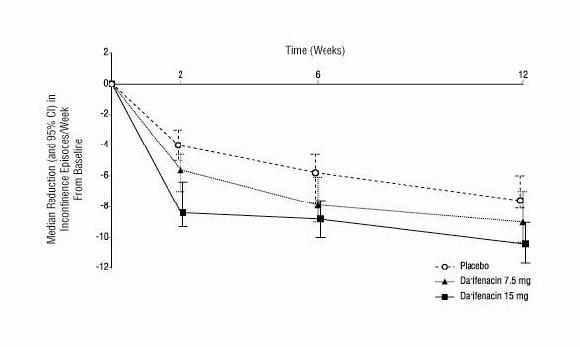
Figures 2 a,b,c. Median Change from Baseline at Weeks 2, 6, 12 for Number of Incontinence Episodes per Week (Studies 1, 2 and 3) Figure 2a, Study 1
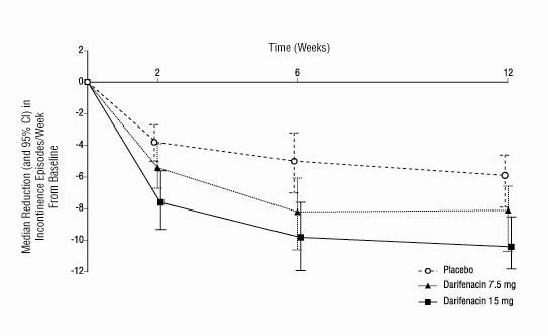
Figure 2b, Study 2
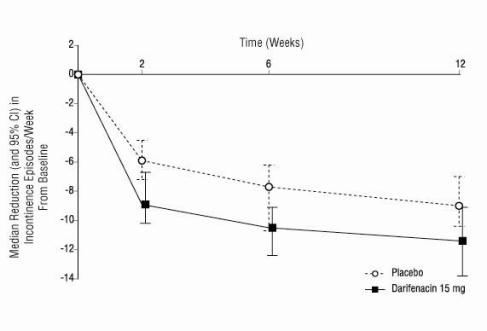
Figure 2c, Study 3
- INDICATIONS AND USAGE
-
CONTRAINDICATIONS
ENABLEX® (darifenacin) extended-release tablets are contraindicated in patients with urinary retention, gastric retention or uncontrolled narrow-angle glaucoma and in patients who are at risk for these conditions. ENABLEX is also contraindicated in patients with known hypersensitivity to the drug or its ingredients.
-
PRECAUTIONS
General
Risk of Urinary Retention
ENABLEX® (darifenacin) extended-release tablets should be administered with caution to patients with clinically significant bladder outflow obstruction because of the risk of urinary retention.
Decreased Gastrointestinal Motility
ENABLEX should be administered with caution to patients with gastrointestinal obstructive disorders because of the risk of gastric retention. ENABLEX, like other anticholinergic drugs, may decrease gastrointestinal motility and should be used with caution in patients with conditions such as severe constipation, ulcerative colitis, and myasthenia gravis.
Controlled Narrow-Angle Glaucoma
ENABLEX should be used with caution in patients being treated for narrow-angle glaucoma and only where the potential benefits outweigh the risks.
Patients with Hepatic Impairment
There are no dosing adjustments for patients with mild hepatic impairment. The daily dose of ENABLEX should not exceed 7.5 mg for patients with moderate hepatic impairment. ENABLEX has not been studied in patients with severe hepatic impairment and therefore is not recommended for use in this patient population (see CLINICAL PHARMACOLOGY, Pharmacokinetics in Special Populations and DOSAGE AND ADMINISTRATION).
Information for Patients
Patients should be informed that anticholinergic agents, such as ENABLEX, may produce clinically significant adverse effects related to anticholinergic pharmacological activity including constipation, urinary retention and blurred vision. Heat prostration (due to decreased sweating) can occur when anticholinergics such as ENABLEX are used in a hot environment. Because anticholinergics, such as ENABLEX, may produce dizziness or blurred vision, patients should be advised to exercise caution in decisions to engage in potentially dangerous activities until the drug’s effects have been determined. Patients should read the patient information leaflet before starting therapy with ENABLEX.
ENABLEX extended-release tablets should be taken once daily with liquid. They may be taken with or without food, and should be swallowed whole and not chewed, divided or crushed.
Drug Interactions
The daily dose of ENABLEX should not exceed 7.5 mg when coadministered with potent CYP3A4 inhibitors (e.g., ketoconazole, itraconazole, ritonavir, nelfinavir, clarithromycin and nefazadone) (see CLINICAL PHARMACOLOGY and DOSAGE AND ADMINISTRATION).
Caution should be taken when ENABLEX is used concomitantly with medications that are predominantly metabolized by CYP2D6 and which have a narrow therapeutic window, such as flecainide, thioridazine and tricyclic antidepressants (see CLINICAL PHARMACOLOGY).
The concomitant use of ENABLEX with other anticholinergic agents may increase the frequency and/or severity of dry mouth, constipation, blurred vision and other anticholinergic pharmacological effects. Anticholinergic agents may potentially alter the absorption of some concomitantly administered drugs due to effects on gastrointestinal motility.
Drug Laboratory Test Interactions
Interactions between darifenacin and laboratory tests have not been studied.
Carcinogenesis/Mutagenesis/Impairment of Fertility
Carcinogenicity studies with darifenacin were conducted in mice and rats. No evidence of drug-related carcinogenicity was revealed in a 24-month study in mice at dietary doses up to 100 mg/kg/day or approximately 32 times the estimated human-free AUC0-24h reached with 15 mg, the maximum recommended human dose (AUC at MRHD) and in a 24-month study in rats at doses up to 15 mg/kg/day or up to approximately 12 times the AUC at MRHD in female rats and approximately eight times the AUC at MRHD in male rats.
Darifenacin was not mutagenic in the bacterial mutation assays (Ames test) and the Chinese hamster ovary assay, and not clastogenic in the human lymphocyte assay, and the in vivo mouse bone marrow cytogenetics assay.
There was no evidence for effects on fertility in male or female rats treated at oral doses up to 50 mg/kg/day. Exposures in this study correspond to approximately 78 times the AUC at MRHD.
Pregnancy Category C
Darifenacin was not teratogenic in rats and rabbits at doses up to 50 and 30 mg/kg/day, respectively. At the dose of 50 mg/kg in rats, there was a delay in the ossification of the sacral and caudal vertebrae which was not observed at 10 mg/kg (approximately 13 times the AUC of free plasma concentration at MRHD). Exposure in this study at 50 mg/kg corresponds to approximately 59 times the AUC of free plasma concentration at MRHD. Dystocia was observed in dams at 10 mg/kg/day (17 times the AUC of free plasma concentration at MRHD). Slight developmental delays were observed in pups at this dose. At 3 mg/kg/day (five times the AUC of free plasma concentration at MRHD) there were no effects on dams or pups. At the dose of 30 mg/kg in rabbits, darifenacin was shown to increase postimplantation loss but not at 10 mg/kg (nine times the AUC of free plasma concentration at MRHD). Exposure to unbound drug at 30 mg/kg in this study corresponds to approximately 28 times the AUC at MRHD. In rabbits, dilated ureter and/or kidney pelvis was observed in offspring at 30 mg/kg/day and one case was observed at 10 mg/kg/day along with urinary bladder dilation consistent with pharmacological action of darifenacin. No effect was observed at 3 mg/kg/day (2.8 times the AUC of free plasma concentration at MRHD). There are no studies of darifenacin in pregnant women. Because animal reproduction studies are not always predictive of human response, ENABLEX should be used during pregnancy only if the benefit to the mother outweighs the potential risk to the fetus.
Nursing Mothers
Darifenacin is excreted into the milk of rats. It is not known whether darifenacin is excreted into human milk and therefore caution should be exercised before ENABLEX is administered to a nursing woman.
Pediatric Use
The safety and effectiveness of ENABLEX in pediatric patients have not been established.
Geriatric Use
In the Phase III fixed-dose, placebo-controlled, clinical studies, 30% of patients treated with ENABLEX were over 65 years of age. No overall differences in safety or efficacy were observed between these patients (n=207) and younger patients <65 years (n=464). No dose adjustment is recommended for elderly patients (see CLINICAL PHARMACOLOGY, Pharmacokinetics in Special Populations and CLINICAL STUDIES).
-
ADVERSE REACTIONS
During the clinical development of ENABLEX® (darifenacin) extended-release tablets, a total of 7,363 patients and volunteers were treated with doses of darifenacin from 3.75 mg to 75 mg once daily.
The safety of ENABLEX was evaluated in Phase II and III controlled clinical trials in a total of 8,830 patients, 6,001 of whom were treated with ENABLEX. Of this total, 1,069 patients participated in three, 12-week, Phase III, fixed-dose efficacy and safety studies. Of this total, 337 and 334 patients received ENABLEX 7.5 mg daily and 15 mg daily, respectively. In all long-term trials combined, 1,216 and 672 patients received treatment with ENABLEX for at least 24 and 52 weeks, respectively.
In all placebo-controlled trials combined, the incidence of serious adverse events for 7.5 mg, 15 mg and placebo was similar.
In all fixed-dose Phase III studies combined, 3.3% of patients treated with ENABLEX discontinued due to all adverse events versus 2.6% in placebo. Dry mouth leading to study discontinuation occurred in 0%, 0.9%, and 0% of patients treated with ENABLEX 7.5 mg daily, ENABLEX 15 mg daily and placebo, respectively. Constipation leading to study discontinuation occurred in 0.6%, 1.2%, and 0.3% of patients treated with ENABLEX 7.5 mg daily, ENABLEX 15 mg daily and placebo, respectively.
Table 4 lists the adverse events reported (regardless of causality) in 2% or more of patients treated with 7.5-mg or 15-mg ENABLEX extended-release tablets and greater than placebo in the three, fixed-dose, placebo-controlled Phase III studies (Studies 1, 2 and 3). Adverse events were reported by 54% and 66% of patients receiving 7.5 mg and 15 mg once-daily ENABLEX extended-release tablets, respectively, and by 49% of patients receiving placebo. In these studies, the most frequently reported adverse events were dry mouth and constipation. The majority of adverse events in ENABLEX-treated subjects were mild or moderate in severity and most occurred during the first two weeks of treatment.
Table 4: Incidence of Adverse Events* Reported in ≥2.0% of Patients Treated with ENABLEX® Extended-Release Tablets and More Frequent with ENABLEX® than with Placebo in Three, Fixed-Dose, Placebo-Controlled, Phase III Studies (Studies 1, 2, and 3) Body System Adverse Event Percentage of Subjects with Adverse Event (%) ENABLEX®
7.5 mg
N=337ENABLEX®
15 mg
N=334Placebo
N=388Digestive Dry Mouth
Constipation
Dyspepsia
Abdominal Pain
Nausea
Diarrhea20.2
14.8
2.7
2.4
2.7
2.135.3
21.3
8.4
3.9
1.5
0.98.2
6.2
2.6
0.5
1.5
1.8Urogenital Urinary Tract Infection 4.7 4.5 2.6 Nervous Dizziness 0.9 2.1 1.3 Body as a Whole Asthenia 1.5 2.7 1.3 Eye Dry Eyes 1.5 2.1 0.5 *Regardless of causality Other adverse events reported, regardless of causality, by ≥1% of ENABLEX patients in either the 7.5 mg or 15 mg once-daily darifenacin-dose groups in these fixed-dose, placebo-controlled Phase III studies include: abnormal vision, accidental injury, back pain, dry skin, flu syndrome, pain, hypertension, vomiting, peripheral edema, weight gain, arthralgia, bronchitis, pharyngitis, rhinitis, sinusitis, rash, pruritus, urinary tract disorder and vaginitis.
Study 4 was a 12-week, placebo-controlled, dose-titration regimen study in which ENABLEX was administered in accordance with dosing recommendations (see DOSAGE AND ADMINISTRATION). All patients initially received placebo or ENABLEX 7.5 mg daily, and after two weeks, patients and physicians were allowed to adjust upward to ENABLEX 15 mg if needed. In this study, the most commonly reported adverse events were also constipation and dry mouth. The incidence of discontinuation due to all adverse events was 3.1% and 6.7% for placebo and for ENABLEX, respectively. Table 5 lists the adverse events (regardless of causality) reported in >3% of patients treated with ENABLEX extended-release tablets and greater than placebo.
Table 5: Number (%) of Adverse Events* Reported in >3% of Patients Treated with ENABLEX® Extended-Release Tablets, and More Frequent with ENABLEX® than Placebo, in the Placebo-Controlled, Dose-Titration, Phase III Study (Study 4) Adverse Event ENABLEX® 7.5 mg/15 mg
N=268Placebo
N=127Constipation
Dry Mouth
Headache
Dyspepsia
Nausea
Urinary Tract Infection
Accidental Injury
Flu Syndrome56 (20.9%)
50 (18.7%)
18 (6.7%)
12 (4.5%)
11 (4.1%)
10 (3.7%)
8 (3.0%)
8 (3.0%)10 (7.9%)
11 (8.7%)
7 (5.5%)
2 (1.6%)
2 (1.6%)
4 (3.1%)
3 (2.4%)
3 (2.4%)*Regardless of causality Acute urinary retention (AUR) requiring treatment was reported in a total of 16 patients in the ENABLEX Phase I-III clinical trials. Of these 16 cases, seven were reported as serious adverse events, including one patient with detrusor hyperreflexia secondary to a stroke, one patient with benign prostatic hypertrophy (BPH), one patient with irritable bowel syndrome (IBS) and four overactive bladder (OAB) patients taking darifenacin 30 mg daily. Of the remaining nine cases, none were reported as serious adverse events. Three occurred in OAB patients taking the recommended doses, and two of these required bladder catheterization for 1-2 days.
Constipation was reported as a serious adverse event in six patients in the ENABLEX Phase I-III clinical trials, including one patient with benign prostatic hypertrophy (BPH), one OAB patient taking darifenacin 30 mg daily, and only one OAB patient taking the recommended doses. The latter patient was hospitalized for investigation with colonoscopy after reporting nine months of chronic constipation that was reported as being moderate in severity.
Postmarketing Experience
The following events have been reported in association with darifenacin use in worldwide postmarketing experience. Because these spontaneously reported events are from the worldwide postmarketing experience, the frequency of events and the role of darifenacin in their causation cannot be reliably determined.
General: hypersensitivity reactions, including angioedema.
Central Nervous: confusion and hallucinations.
Cardiovascular: palpitations
-
OVERDOSAGE
Overdosage with antimuscarinic agents, including ENABLEX® (darifenacin) extended-release tablets, can result in severe antimuscarinic effects. Treatment should be symptomatic and supportive. In the event of overdosage, ECG monitoring is recommended. ENABLEX has been administered in clinical trials at doses up to 75 mg (five times the maximum therapeutic dose) and signs of overdose were limited to abnormal vision.
-
DOSAGE AND ADMINISTRATION
The recommended starting dose of ENABLEX® (darifenacin) extended-release tablets is 7.5 mg once daily. Based upon individual response, the dose may be increased to 15 mg once daily, as early as two weeks after starting therapy.
ENABLEX extended-release tablets should be taken once daily with liquid. They may be taken with or without food, and should be swallowed whole and not chewed, divided or crushed.
For patients with moderate hepatic impairment or when coadministered with potent CYP3A4 inhibitors (e.g., ketoconazole, itraconazole, ritonavir, nelfinavir, clarithromycin and nefazadone), the daily dose of ENABLEX should not exceed 7.5 mg. ENABLEX is not recommended for use in patients with severe hepatic impairment (see CLINICAL PHARMACOLOGY and PRECAUTIONS).
-
HOW SUPPLIED
ENABLEX® 7.5 mg extended-release tablets are round, shallow, convex, white-colored tablets, and are identified with “DF” on one side and “7.5” on the reverse.
Bottle of 30 NDC 54868-5704-0
ENABLEX® 15 mg extended-release tablets are round, shallow, convex, light peach-colored tablets, and are identified with “DF” on one side and “15” on the reverse.
Bottle of 30 NDC 54868-5363-0
-
INFORMATION FOR PATIENTS
ENABLEX® (ěn-ā-blěx)
(darifenacin)
Extended-release tablets
7.5 mg or 15 mg
Rx only
Read the Patient Information that comes with ENABLEX® before you start taking it and each time you get a refill. There may be new information. This leaflet does not take the place of talking to your doctor or other healthcare professional about your medical condition or your treatment. Only your doctor or healthcare professional can determine if treatment with ENABLEX is right for you.
What is ENABLEX?
ENABLEX is a prescription medicine used in adults to treat the following symptoms due to a condition called overactive bladder:
- having a strong need to go to the bathroom right away (also called “urgency”)
- leaking or wetting accidents (also called “urinary incontinence”)
- having to go to the bathroom too often (also called “urinary frequency”)
What is overactive bladder?
Overactive bladder happens when you cannot control your bladder contractions. When these muscle contractions happen too often or cannot be controlled, you get symptoms of overactive bladder, which are urinary urgency, urinary incontinence (leakage) and urinary frequency.
Who should not take ENABLEX?
Do not take ENABLEX if you:
- are not able to empty your bladder (also called “urinary retention”)
- have delayed or slow emptying of your stomach (also called “gastric retention”)
- have an eye problem called “uncontrolled narrow-angle glaucoma”
- are allergic to ENABLEX or to any of its ingredients. See the end of this leaflet for a complete list of ingredients.
ENABLEX has not been studied in children.
What should I tell my doctor before starting ENABLEX?
Before starting ENABLEX, tell your doctor or healthcare professional about all of your medical conditions including if you:
- have any stomach or intestinal problems, or problems with constipation
- have trouble emptying your bladder or if you have a weak urine stream
- have an eye problem called narrow-angle glaucoma
- have liver problems
- are pregnant or are planning to become pregnant. It is not known if ENABLEX can harm your unborn baby.
- are breast-feeding. It is not known if ENABLEX passes into breast milk and if it can harm your baby.
Tell your doctor about all the medicines you take, including prescription and nonprescription medicines, vitamins, and herbal supplements. ENABLEX and certain other medicines can interact with each other, causing side effects. Especially tell your doctor if you take:
- ketoconazole (Nizoral®) or itraconazole (Sporanox®), antifungal medicines
- clarithromycin (Biaxin®), an antibiotic medicine
- ritonivir or nelfinavir (Viracept®), antiviral medicines
- nefazadone (Serzone®), a depression medicine
- flecainide (Tambocor™), an abnormal heartbeat (antiarrhythmia) medicine
- thioridazine (Mellaril®), a mental disorder (antipsychotic) medicine
- a medicine called a tricyclic antidepressant
Know all the medicines you take. Keep a list of them with you to show your doctor and pharmacist each time you get a new medicine.
How should I take ENABLEX?
Take ENABLEX exactly as prescribed. Your doctor will prescribe the dose that is right for you. Your doctor may prescribe the lowest dose if you have certain medical conditions such as liver problems.
- You should take ENABLEX once daily with liquid.
-
ENABLEX should be swallowed whole and not chewed, divided or crushed.
- ENABLEX may be taken with or without food.
- If you miss a dose of ENABLEX, begin taking ENABLEX again the next day. Do not take two doses of ENABLEX in the same day.
- If you take too much ENABLEX, call your local Poison Control Center or emergency room right away.
What are the possible side effects of ENABLEX?
The most common side effects with ENABLEX are:
- dry mouth
- constipation
ENABLEX may cause other less common side effects that include:
- blurred vision. Use caution while driving or doing dangerous activities until you know how ENABLEX affects you.
- heat prostration. Heat prostration (due to decreased sweating) can occur when drugs such as ENABLEX are used in a hot environment.
These are not all the side effects with ENABLEX. For more information, ask your doctor, healthcare professional or pharmacist.
How do I store ENABLEX?
-
Keep ENABLEX and all medicines out of the reach of children.
- Store ENABLEX at room temperature, 59 to 86ºF (15 to 30ºC). Protect from light.
- Safely dispose of ENABLEX that is out of date or no longer needed.
General information about ENABLEX
Medicines are sometimes prescribed for conditions that are not mentioned in patient information leaflets. Do not give ENABLEX to other people, even if they have the same symptoms you have. It may harm them.
This leaflet summarizes the most important information about ENABLEX. If you would like more information, talk with your doctor. You can ask your pharmacist or doctor for information about ENABLEX that is written for health professionals. You can also call the product information department at 1-888-44-ENABLEX (1-888-443-6225) or visit the website at www.Enablex.com.
What are the ingredients in ENABLEX?
Active Ingredient: darifenacin
Inactive Ingredients: dibasic calcium phosphate, hypromellose (hydroxypropyl methylcellulose), magnesium stearate, polyethylene glycol, talc, titanium dioxide. The 15 mg tablet also contains iron oxide red and iron oxide yellow.
Appearance:
The 7.5-mg tablet is round and white-colored with “DF” on one side and “7.5” on the other side.
The 15-mg tablet is round and peach-colored with “DF” on one side and “15” on the other side.
* Mellaril® is a registered trademark of Novartis. The other brands listed are the trademarks of their respective owners and are not trademarks of Novartis.
REV: JANUARY 2010 T2010-05
Manufactured by:
Novartis Pharma Stein AG,
Stein, Switzerland
Distributed by:
Novartis Pharmaceuticals Corporation
East Hanover, New Jersey 07936
Marketed with:
Warner Chilcott Pharmaceuticals Inc.
Mason, Ohio 45040
© Novartis
Relabeling of "Additional Barcode" label by:
Physicians Total Care, Inc.
Tulsa, OK 74146
- having a strong need to go to the bathroom right away (also called “urgency”)
- PRINCIPAL DISPLAY PANEL
- PRINCIPAL DISPLAY PANEL
-
INGREDIENTS AND APPEARANCE
ENABLEX
darifenacin tablet, extended releaseProduct Information Product Type HUMAN PRESCRIPTION DRUG Item Code (Source) NDC:54868-5704(NDC:0078-0419) Route of Administration ORAL Active Ingredient/Active Moiety Ingredient Name Basis of Strength Strength DARIFENACIN (UNII: APG9819VLM) (DARIFENACIN - UNII:APG9819VLM) DARIFENACIN 7.5 mg Inactive Ingredients Ingredient Name Strength ANHYDROUS DIBASIC CALCIUM PHOSPHATE (UNII: L11K75P92J) HYPROMELLOSE (UNII: 3NXW29V3WO) POLYETHYLENE GLYCOL (UNII: 3WJQ0SDW1A) MAGNESIUM STEARATE (UNII: 70097M6I30) TITANIUM DIOXIDE (UNII: 15FIX9V2JP) TALC (UNII: 7SEV7J4R1U) Product Characteristics Color white (white) Score no score Shape ROUND Size 8mm Flavor Imprint Code DF;7;5 Contains Packaging # Item Code Package Description Marketing Start Date Marketing End Date 1 NDC:54868-5704-0 30 in 1 BOTTLE Marketing Information Marketing Category Application Number or Monograph Citation Marketing Start Date Marketing End Date NDA NDA021513 11/06/2006 ENABLEX
darifenacin tablet, extended releaseProduct Information Product Type HUMAN PRESCRIPTION DRUG Item Code (Source) NDC:54868-5363(NDC:0078-0420) Route of Administration ORAL Active Ingredient/Active Moiety Ingredient Name Basis of Strength Strength DARIFENACIN (UNII: APG9819VLM) (DARIFENACIN - UNII:APG9819VLM) DARIFENACIN 15 mg Inactive Ingredients Ingredient Name Strength ANHYDROUS DIBASIC CALCIUM PHOSPHATE (UNII: L11K75P92J) FERRIC OXIDE RED (UNII: 1K09F3G675) HYPROMELLOSE (UNII: 3NXW29V3WO) POLYETHYLENE GLYCOL (UNII: 3WJQ0SDW1A) MAGNESIUM STEARATE (UNII: 70097M6I30) TITANIUM DIOXIDE (UNII: 15FIX9V2JP) TALC (UNII: 7SEV7J4R1U) FERRIC OXIDE YELLOW (UNII: EX438O2MRT) Product Characteristics Color orange (Light Peach) Score no score Shape ROUND Size 8mm Flavor Imprint Code DF;15 Contains Packaging # Item Code Package Description Marketing Start Date Marketing End Date 1 NDC:54868-5363-0 30 in 1 BOTTLE Marketing Information Marketing Category Application Number or Monograph Citation Marketing Start Date Marketing End Date NDA NDA021513 07/20/2005 Labeler - Physicians Total Care, Inc. (194123980) Establishment Name Address ID/FEI Business Operations Physicians Total Care, Inc. 194123980 relabel

